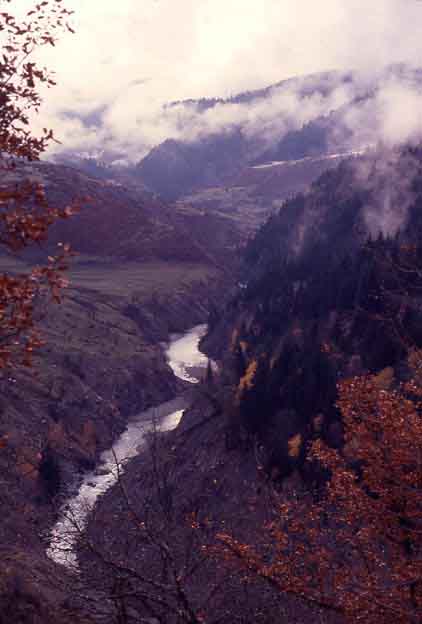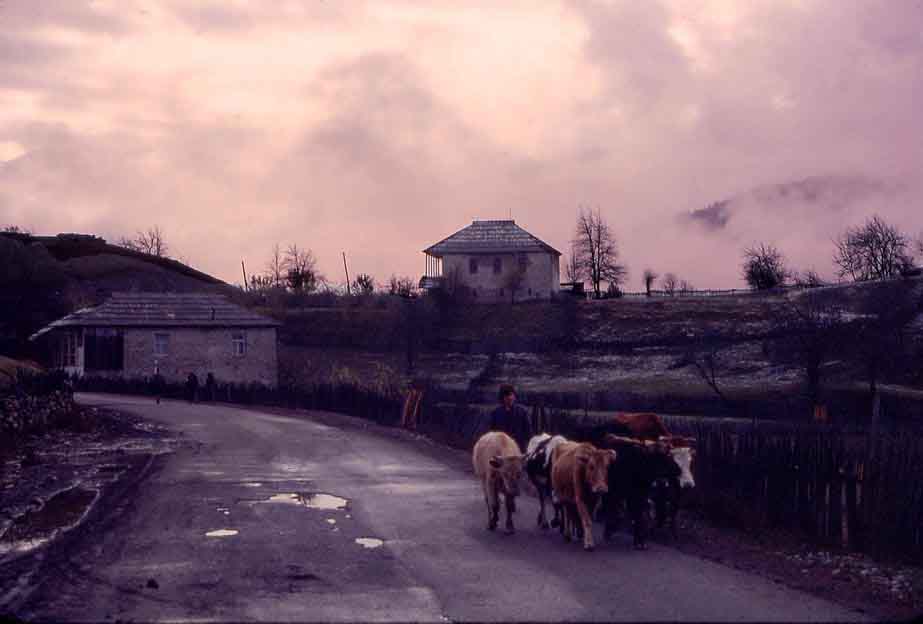
The lower end of the Inguri Gorge. This part may now have been submerged in a new reservoir.
Click on the pictures, some can be enlarged!
|
Svaneti in the Snow November 28 - 29, 1980 |
At an altitude of 2000 meters, in the center of the western range of the Caucasus lies the mythical Valley of Svanetia. Until the middle of the 20th century, when the Russians built a road along the Inguri Valley, it could only be reached on foot or horse-back and had, therefore, never been conquered by any intruder from the Romans, Persians, and Turks to their Russian successors. Which gave the valley the honorable name Free Svaneti. Even during WW II the fiercely independent Svans were exempted from military service in the Soviet Army.
Due to this splendid isolation the Swans speak a prehistoric Georgian dialect and jealously guard their old-fashioned conservative customs, innumerable old churches, frescoes, and icons. Christianity arrived before the 9th century and got hopelessly mixed up with ancient animist rites which make Svaneti an art-historical and anthropological treasure trove.
But all of this knowledge one can read in books or the internet - I never got far enough into the heart of the Upper Svaneti to have seen or experienced any of this, not even the legendary hospitality of the Svans..... The first snowstorm of the season cut our visit short and drove us back to Tbilisi.
At the end of November 1980 Merab drove us to Mestia, the Capital of Svaneti in one of his more heroic driving efforts. We spent the night in the "hotel" of the Georgian Alpine Club, where the only source of heat were cups of tea we brewed in the hotel's tooth-mugs with an immersion heater bought in New Dehli. The restaurant offered only Russian style cold cuts.... Next morning we set out on a break-neck drive across a pass to Iprari where we hoped to see one of the old churches. On the pass it began to rain and in Iprari the rain turned into snow - besides the school teacher who had the key to the church was in no mood to unlock it. Meanwhile the children sang derisive ditties on the foreigners and threw stone at us..... With a heavy heart I persuaded Merab to turn back. His car skidded and slipped on the rocks of the unpaved road to the pass. We heated lots of more tea that night. Next morning the world was white....
There exist many pictures of the tower villages of Svaneti and the icy peaks of the mountains surrounding it, but few were taken after the first - albeit mild - snowstorm at the end of November....
Merab's second valiant attempt to take me to Svaneti in 1984 ended in the Village of Djvari at the entry to the Inguri Gorge - it rained so hard that it would have been foolish to try to drive up the dangerous road through the Inguri Valley to Mestia.
And an offer of Brigitta and Rolf Schrade, who restore frescoes in the churches of Svaneti, to take me along has for various reasons been foiled for the past six years....
|
The lower end of the Inguri Gorge. This part may now have been submerged in a new reservoir. |
|
We met this sled-like transportation, which the Svans use winter and summer because the roads are unsuitable for wheels, on the way to Mestia. You see that this is Christian land, a smiling Deda (Mother) and Biji sit in the basket, while Mama (father) - who looks a little dense (there is quite a lot of inbreeding in Svaneti) - leads the oxen. In Islamic countries their roles would be reversed. |
|
A first tower village playing hide and seek in the clouds. Like in Southern Tuscany or the Mani in Greece the towers offered refuge from enemies and defense in the fierce blood-feuds with the neighbors. The family who owned the higher tower won.... |
|
Iprari on the ledge above the upper Inguri. One of the famous pilgrims churches of Svaneti can be seen on the next higher ridge. |
|
Gotcha, the Wise Woman of Adishi above Iprari (Jeffrey fecit) |
|
First snow! |
|
Mestia next morning |
|
The towers of Mestia in the snow. The former slate roofs have during Soviet times be replaced by tin sheets |
|

Before sunrise near Mestia |
|
Leila Mta at sunrise |
Merab insisted that we had at least to see Mt. Ushba, the double-peaked Matterhorn of Svaneti and took a narrow side road to a valley below Betcho Pass, where we waited for one-and-a-half hour in the freezing cold - for the clouds to lift. They never did, and we never saw Ushba - but the continuously shifting clouds produced a drama all of their own.
|
Merab wearing a Svani scull-cap talks to the cow herd. |
|
During the entire time there was not a breeze. These clouds ride inversions and shifted solely on local thermals. |